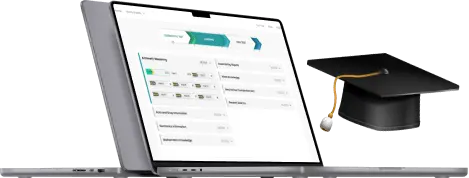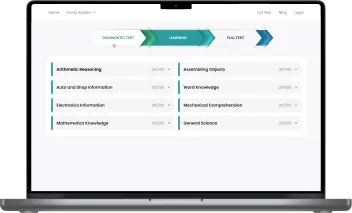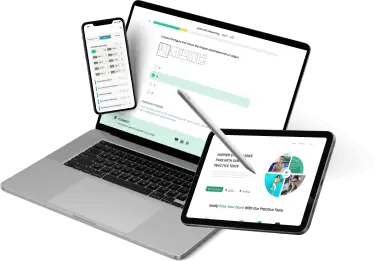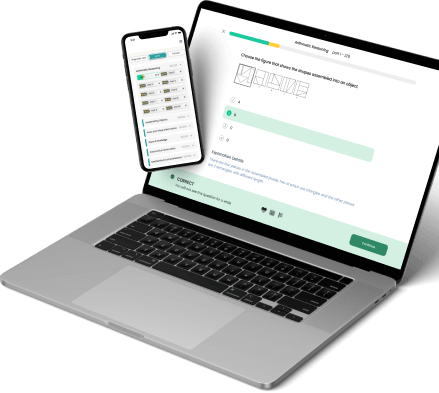Fun & effective APUSH practice test tool to pass with flying colors
All-in-one platform with everything you need to ace the APUSH on your first attempt
Clear and Thorough Learning Path
Proven APUSH 3-step Practice Formula
After our 100,000+ users' success stories, we developed a 3-step strategy to provide you with the most precise and in-depth learning path while minimizing your prep time.APUSH Diagnostic Test
First, take this short test and get your detailed report showing your strong and weak areas. Save your time by concentrating on what is in demand.Learning
With quick, bite-sized learning techniques and a detailed study guide for each APUSH section, you can really strengthen your weaknesses (from step 1) and boost your scores.APUSH Full Test
The last step for your preparation is taking our full APUSH practice tests and seeing how far you've come since the beginning. Repeat the 3-step formula until you are satisfied with your results!Ready to start?
Thousands of APUSH users already accomplished their goals.NOW it’s your turn!

What You Get

All-in-one platform
A complete APUSH Prep Platform, including a diagnostic test, detailed study guides for all topics, practice questions with step-by-step explanations, and various full simulator tests.
Questions nearly identical to those in the real APUSH test
All questions are categorized into the specific sections as on the real APUSH: Same format & same difficulty!
Best for the busy
Easily & quickly grasp all the knowledge with our unique learning technique. And you can learn anytime, anywhere on any devices, even with a few free minutes.
Practice while having fun
Learn and play! Complete round-by-round to reach your daily achievement and make progress on your learning journey!Featured on















What our users are saying
Over 50,000 aspiring American candidates use APUSH monthlyAce the APUSH Exam with our comprehensive guide! Get expert tips, practice questions, and key historical concepts to help you conquer the APUSH Exam and achieve a top score. Master the content and strategies you need to succeed on the APUSH Exam and excel in your American History studies.
After completing an Advanced Placement U.S. History course at your high school, you will take the AP® U.S. History exam, also known as APUSH. Students must answer 55 multiple-choice questions, 3 short-answer questions, 1 document-based question, and 1 long essay question during the exam's 3 hours and 15 minutes duration. You could receive college credit if you achieve a high enough score!
In-depth analysis, critical reading, and writing are all part of the AP US History exam. It requires more than simply memorization of names and dates. You must also be able to quickly and accurately interpret historical evidence, recall outside information on a topic, and synthesize your ideas into a coherent argument.
What Does The APUSH Exam Cover?
Your AP teacher must cover specific topics required by the College Board for the AP U.S. History course. As you finish your APUSH review, be sure you are knowledgeable about the following topics:
- Unit 1: Period 1: 1491–1607 (4–6%): Contact among the peoples of Europe, the Americas, and West Africa gave rise to a new world on the continent of North America ruled by American Indians.
- Unit 2: Period 2: 1607–1754 (6–8%): As Europeans and American Indians fought and maneuvered for security, dominance, and control in North America, distinctive colonial and native societies developed.
- Unit 3: Period 3: 1754–1800 (10–17%): A new American republic was created as a result of British imperial attempts to reclaim control over its colonies and the colonists' response to those attempts, as well as conflicts over the new nation's social, political, and economic identity.
- Unit 4: Period 4: 1800–1848 (10–17%): In the face of rapid changes in the economy, the territory, and the demography, the new republic fought to define and extend democratic ideals.
- Unit 5: Period 5: 1844–1877 (10–17%): As the country developed in size and population, regional conflicts, particularly those involving slavery, sparked a civil war whose course and aftermath radically changed American society.
- Unit 6: Period 6: 1865–1898 (10–17%): Economic, political, diplomatic, social, environmental, and cultural changes resulted from the United States' transformation from an agricultural to an increasingly industrialized and urban society
- Unit 7: Period 7: 1890–1945 (10–17%): A more diverse United States grappled with significant domestic and global issues, debated the proper degree of government activism, and sought to define its role in the world.
- Unit 8: Period 8: 1945–1980 (10–17%): After World War II, the United States struggled to uphold its ideals while dealing with prosperity and new international responsibilities.
- Unit 9: Period 9: 1980–Present (4–6%): The United States underwent renewed ideological and cultural conflicts as it entered a new century full of opportunities and challenges. It also attempted to redefine its foreign policy as it adjusted to economic globalization and revolutionary changes in science and technology.
- There are two sections in the AP U.S. History exam: Sections 1 and 2. Section 1 is further divided into Part A (multiple choice questions) and Part B (four short answer questions). Writing is required for Section 2, where students must answer a long essay question as well as a document-based question.
Section 1, Part A: Multiple Choice
This section lasts for 55 minutes and accounts for 40% of your overall score. In this section of the exam, you will be given 55 questions, each of which has four answer choices. They come in sets of three to four questions in which you are given a stimulus, or a source, such as a historical text, a graph, or a map, and answer a question based on it.
Section 1, Part B: Short-answer questions
You have 40 minutes to complete three short-answer questions or roughly 13 minutes for each question. It contributes 20% of your final score. You must answer the first two questions, and you can select either question 3 or question 4 for your third short answer.
Section 2, Part A: Document-Based Question
Writing an essay based on a prompt and seven historical documents is what you are required to do in this part, which accounts for 25% of your overall score. After reading for 15 minutes, you'll have 45 minutes to write your response. This part will focus on a historical development during the 1754-1980 period.
Section 2, Part B: Long Essay
The Long Essay is the last part of the AP US History exam, and you must select one of three possible prompts and write an essay on the subject. You must complete your response, which will account for 15% of your final AP score, in 40 minutes. You must make a coherent and logical argument, and support it with relevant historical evidence (which won't be given to you directly, unlike on the DBQ), and receive full credit.
How Is the APUSH Exam Scored?
We'll go through how each component of the APUSH exam is scored, graded, and combined to give you your total AP score on a scale of 1 to 5.
On the multiple-choice portion, you receive one raw point for each right answer; so, the maximum score you may receive is 55 points. For erroneous replies, no points are deducted.
Each of the three short-answer questions is worth three points, for a total of nine points in this area.
According to the scoring guide, the DBQ is scored out of 7 points and is based on the following criteria:
- 1 point for Thesis/claim.
- 1 point for Contextualization
- 2 points for Evidence from evidence
- 1 point for Evidence beyond evidence
- 1 point for Sourcing
- 1 point for Complexity
Finally, the Long Essay is assessed out of 6 raw points based on the following criteria:
- 1 point for Thesis/claim.
- 1 point for Contextualization
- 2 points of Evidence
- 2 points for Analysis and reasoning
On essay questions, mistakes are deducted only if they detract from the validity of the argument (in other words, don't make up historical facts to support your argument). Grammatical and other technical faults are acceptable as long as they do not interfere with the grader's ability to grasp what your essay is expressing.
You can get a total of 77 raw points on the APUSH exam:
- Multiple Choice Questions: 55 points
- Short Answer Questions: 9 points
- DBQ: 7 points.
- The Long Essay: 6 points.
Raw scores can be adjusted to a maximum of 150 points. This is how you do it for each section:
- Multiple Choice: Take your raw multiple-choice section score out of 55 and multiply it by 1.09.
- Short Answer: Take your raw short-answer section score out of 9 and multiply it by 3.33.
- DBQ: Take your raw DBQ section score out of 7 and multiply it by 5.36.
- Long Essay: Take your raw Long Essay section score out of 6 and multiply it by 3.75.
Finally, total all of your scores to earn your final scaled AP score for APUSH! Here's a graphic that shows how these scaled scores correspond to final AP scores:
|
Scaled Score |
AP Score |
% of Students Who Earned Score (2022) |
|
115-150 |
5 |
10.8% |
|
90-114 |
4 |
15.6% |
|
65-89 |
3 |
21.9% |
|
44-64 |
2 |
23.0% |
|
0-43 |
1 |
28.8% |
How To Prepare For The APUSH Exam?
Begin studying six to eight weeks before the AP US History exam. Students should develop a study schedule and start preparing in early March. Because the course is organized into 9 units, you might review 1-2 units every week if you begin studying 6 weeks before the exam. As you go over the material, be sure to include free-answer questions and multiple-choice practice questions.
Unless you start late, there is no need to take a baseline. Before preparing for many standardized examinations, students want to take a baseline test to determine their strengths and weaknesses. A baseline is not suggested for APUSH since students may not have studied all of the material in their class when they begin studying, and they may have forgotten part of the material from earlier in the year. The only exception to this "no-baseline" approach would be if a student waited until the last minute to study (say, 1-2 weeks before the exam) and wanted to identify which areas were weakest and needed the most revision.
- Actively study. An APUSH course covers a lot of information, yet simply going through notes or highlighted sections of the textbook will not assure that you understand everything. While reviewing the stuff, you must do something with it!
- Consider creating individual timeframes for each unit. Take note of the dates at the start and conclusion of the Unit; they are carefully chosen. Consider why these dates were selected to bookend the unit.
- Create a PERSIA chart for each unit, documenting advances in Political, Economic, Religious, Social, Intellectual/Industrial, and Artistic areas.
- Make your textbook's headers and subheadings into questions, and then respond to them.
- Have a parent or study partner quiz you on those questions to check that you can recollect and regurgitate the knowledge to them.
- Practice both multiple-choice and FRQ questions.
- Focus on topics from Units 3-8 (1754-1980), which accounts for 80% of test questions; if you can't study everything, concentrate on these time spans.
Keep in mind that you're aiming to determine how well you know the content. Forcing yourself to answer questions regarding the material can help you determine how effectively you've retained the knowledge.
Are you overwhelmed by all of this information? You can start preparing for AP US History right now with the aid of our AP US History Practice Tests! Consider each issue on an AP U.S. History Practice Test as a mini-quiz to assess your understanding. Each test contains questions that are identical to those on the actual exam. If you miss a question, you may find out what went wrong by reading the detailed explanation. By taking our AP U.S. History Practice Tests, you can be certain that you've learned everything you need to know and are completely prepared for the AP U.S. History test!
4 Crucial Tips for Acing the APUSH Exam
AP U.S. History is a difficult exam that demands intensive critical thinking and analytical abilities. Here are some pointers to keep in mind if you want to do well on exam day.
1. Don't confuse correct answers with accurate facts.
Many multiple-choice questions will provide responses that are accurate approximations of historical events or patterns but do not directly address the question. Be aware of these exam answers so you don't pick them by accident over more relevant ones.
One wrong answer in the multiple-choice question I used above was "the growth of the internal slave trade." This was a true trend at the time cited in the question, but because it does not directly connect to the paragraph given, it is still the incorrect response.
Don't allow these response options to confuse you; stick to the specifics of the question and the evidence offered to you!
2. Pay Attention to Details—Carefully Read Excerpts
Because the majority of this AP test is dependent on historical reference sources, you won't be able to answer questions accurately unless you read attentively. Even if you know everything there is to know about US history, it will largely serve to contextualize the data provided on the test. The exact facts revealed by the texts and visuals will eventually disclose the right response choice.
3. Make a Plan Before You Write
On the APUSH exam, it is necessary to produce well-organized, focused essays. The first item on the agenda is a clear thesis. The rest of your essay should then relate back to your argument and present relevant proof throughout. If you start writing an essay without first organizing your thoughts, you're more likely to ramble or veer off-topic from the core point of the inquiry.
For the DBQ, you should prepare how to arrange your thoughts and use the many papers as evidence for 15 of the 60 minutes. While you will have less time for the Long Essay, you should still spend five minutes or so before beginning to write a quick outline.
4. Make Use of Outside Evidence Wisely
It's a good idea to include more background information in your AP US History DBQ and Long Essay solutions. It demonstrates that you understand the content and can relate themes to what you learned in class rather than just what was provided to you in the question.
However, only add outside expertise if it significantly strengthens your case. If you merely put stuff in there to show how much you know, your essay will be unfocused and you may lose points.
This is why it is critical to plan ahead of time. During the brainstorming stage, you can consider examples that relate to your thesis and carefully put them throughout your essay in ways that help to support your point.
How to Utilize our APUSH Practice Test?
When you're ready to begin taking practice tests, follow these steps:
- With your notes and real estate study guide close at hand, take the first test without a time limit. Put the strategies you have learned into practice and take your time.
- Consider setting a timer and pacing yourself to complete the second practice test "open book" as well.
- Practice any other tests as if it was test day. Put your study materials away and set a timer. Imagine yourself sitting at a desk in the testing center, answering questions as quickly and accurately as possible.
- Practice tests are best taken regularly until you run out of them or the actual test is approaching. This will prepare your mind for the test day schedule and stress, so you can concentrate on recalling the material you've learned.
How Does Our APUSH Practice Test Work?
Based on the APUSH official test
We have to say our APUSH practice test questions are collected and updated carefully based on the annual real estate test. In order to be as similar as possible to the real test, we constantly improve the quality as well as quantity of our real estate practice test questions.
Detailed explanations
We also offer detailed explanations for every question, which help you understand the roots of the issues and rarely make that mistake again, so you pass the test the first time!
So friendly to users
Our APUSH practice tests are designed to be fun and easy to use which helps you feel more interested while doing tests.
Why you should study with our APUSH Practice Exam Free?
These are all the benefits of using our APUSH Practice Test:
- Study anywhere at any time without an Internet connection.
- Your own study plan will be set up automatically according to your test date
- 3 features: Weak/Medium/Strong questions help you clearly determine which area you should work harder on.
- Customize your study reminder to receive a notification at any time you want
FAQs
Is APUSH a hard AP exam?
AP US History is a difficult advanced placement high school subject. The course covers centuries of content and necessitates keen analytical abilities. When compared to other AP tests, the AP U.S. History exam has a comparatively low pass rate. Even though it is a demanding subject, many students find it worthwhile.
How hard is the APUSH exam?
APUSH is rated moderately tough by class alumnae, with 5.9/10 for total difficulty, ranking it 11th out of the 28 big AP classes examined.
Is APUSH the hardest AP class?
APUSH difficulty is among the most demanding AP® courses and tests. However, don't let this information deter you from taking the course or test.
Does APUSH matter for colleges?
Before graduating, several universities require students to complete a history credit. However, if you take the AP® U.S. History Exam and achieve a particular score, you may be able to receive credit for that requirement. The exam covers all of American history from 1491 to the present, with a concentration on seven major themes.
In conclusion, thorough preparation for the APUSH Exam is crucial to achieving success on test day. By understanding the exam format, familiarizing yourself with the content, and utilizing effective study techniques, you can boost your confidence and maximize your chances of earning a high score. Taking advantage of practice exams and review resources will not only help you identify areas for improvement but also refine your time management skills and test-taking strategies. Remember, the APUSH Exam is an opportunity to showcase your knowledge of American history and demonstrate your ability to analyze historical events and themes. By dedicating time and effort to your preparation, you can approach the APUSH Exam with confidence and achieve the results you desire. Best of luck as you embark on this rewarding academic journey!






